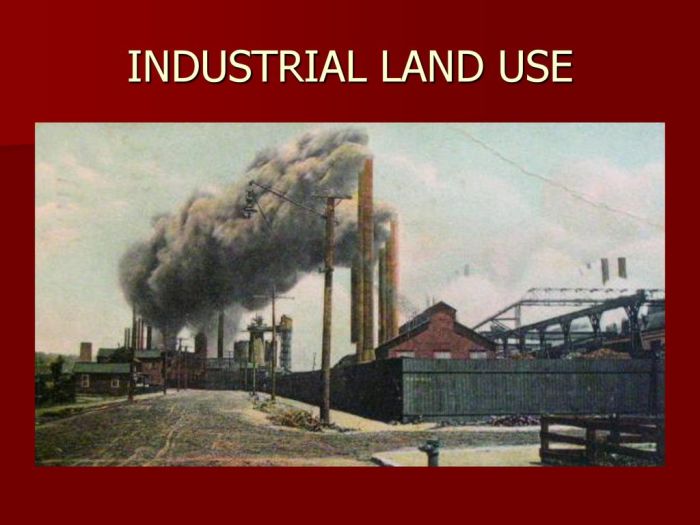Industrial Investment Property A Guide to Profitable Opportunities

Industrial investment property presents a unique and potentially lucrative opportunity for savvy investors. This sector, driven by the ever-growing demand for warehousing, manufacturing, and distribution space, offers a distinct blend of long-term stability and potential for significant returns.
Understanding the dynamics of the industrial real estate market, the intricacies of investment considerations, and the nuances of due diligence is crucial for success in this field. This guide delves into the essential aspects of industrial investment, equipping you with the knowledge and insights to navigate this complex yet rewarding landscape.
Defining Industrial Investment Property

Industrial investment property refers to real estate specifically designed and utilized for industrial purposes, encompassing various types of buildings and land. These properties cater to manufacturing, storage, distribution, and other related activities.
Key Characteristics of Industrial Properties
Industrial properties differ significantly from other real estate categories due to their unique characteristics. These include:
- Functional Design: Industrial properties are built with specific functions in mind, prioritizing efficient use of space, accessibility, and functionality. For example, warehouses often feature high ceilings, loading docks, and ample parking.
- Location and Infrastructure: Proximity to transportation networks, including highways, railways, and ports, is crucial for industrial properties. They often require access to utilities like electricity, gas, and water, as well as sufficient land for expansion.
- Construction Materials: Industrial properties typically employ durable and robust materials like concrete, steel, and metal, designed to withstand heavy loads and industrial processes.
- Zoning Regulations: Industrial properties are subject to specific zoning regulations that dictate permissible uses, building codes, and environmental restrictions.
Types of Industrial Properties
The industrial real estate sector encompasses a wide range of property types, each tailored to specific needs and operations.
- Warehouses: These properties are designed for storing goods and materials, often featuring large, open spaces, high ceilings, and loading docks.
- Factories: Factories are facilities dedicated to manufacturing and production processes. They typically incorporate machinery, equipment, and specialized infrastructure.
- Distribution Centers: Distribution centers act as hubs for receiving, sorting, and distributing goods to retailers and consumers. They often require efficient layouts and advanced logistics systems.
- Manufacturing Facilities: Manufacturing facilities are dedicated to the production of goods, ranging from small-scale workshops to large-scale industrial complexes. They often require specialized equipment, power sources, and environmental controls.
Market Dynamics and Trends
The industrial real estate market is a dynamic and constantly evolving sector influenced by a multitude of factors. Understanding the current market dynamics and emerging trends is crucial for investors seeking to capitalize on opportunities and mitigate risks within this asset class.
Supply and Demand Trends
The balance between supply and demand is a key driver of industrial real estate values. In recent years, the industrial sector has experienced strong demand, fueled by the growth of e-commerce, manufacturing reshoring, and the need for larger distribution centers to accommodate supply chain complexities. This surge in demand has led to tight vacancy rates and upward pressure on rental rates in many markets. However, there are also areas experiencing oversupply, particularly in regions with limited population growth or where industrial development has outpaced demand.
Factors Influencing Industrial Investment Property Values
Several factors influence the value of industrial investment properties.
Economic Growth
A strong economy typically translates into increased demand for industrial space, as businesses expand operations and require additional warehousing and manufacturing facilities. Conversely, economic downturns can lead to decreased demand and lower property values.
Technological Advancements
Technological advancements, such as automation and robotics, are transforming the industrial landscape. These innovations are driving efficiency and productivity gains, but they can also lead to shifts in demand for different types of industrial space. For example, the rise of automated warehouses may reduce the need for traditional distribution centers with large labor forces.
E-Commerce
The rapid growth of e-commerce has significantly impacted the industrial real estate market. E-commerce companies require large fulfillment centers to handle online orders and manage inventory. This has driven demand for modern, well-located industrial properties with features such as high ceilings, ample parking, and proximity to transportation hubs.
Emerging Trends in the Industrial Sector
The industrial sector is constantly evolving, with several emerging trends shaping the future of industrial investment.
Rise of Logistics and Fulfillment Centers
The increasing popularity of online shopping has fueled the growth of logistics and fulfillment centers. These facilities are strategically located to facilitate efficient delivery networks and meet the demands of e-commerce giants like Amazon and Walmart.
Focus on Sustainability
Sustainability is becoming increasingly important in the industrial sector. Investors are seeking properties with energy-efficient features, renewable energy sources, and environmentally friendly practices. This trend is driven by environmental concerns, rising energy costs, and government regulations.
Growth of Last-Mile Delivery
The need for fast and convenient delivery has led to the growth of last-mile delivery networks. This trend is driving demand for smaller industrial properties located close to urban centers, where goods can be quickly delivered to customers.
Adoption of Advanced Technologies
The industrial sector is embracing advanced technologies such as artificial intelligence (AI), Internet of Things (IoT), and robotics. These technologies are improving efficiency, optimizing operations, and enhancing data analytics.
Focus on Workforce Development
As the industrial sector evolves, there is a growing need for skilled labor. Companies are investing in workforce development programs to attract and retain talent, ensuring they have the necessary skills to operate advanced technologies and manage complex supply chains.
Investment Considerations

Investing in industrial real estate requires a thorough understanding of various factors that can influence the success of your investment. It is crucial to conduct comprehensive due diligence and consider the following aspects to make informed decisions.
Location
The location of an industrial property is a critical factor that impacts its value and potential for future growth. Industrial properties are often located in areas with good access to transportation infrastructure, such as highways, railways, and airports. This accessibility is essential for businesses that rely on efficient logistics and distribution networks.
- Proximity to major transportation hubs, including highways, railways, and airports, enhances the property’s value and attractiveness to tenants.
- The presence of a skilled workforce and a supportive business environment can also influence the desirability of a location.
- Local zoning regulations and potential future development plans should be carefully reviewed to understand any limitations or opportunities associated with the property.
Size and Condition
The size and condition of an industrial property are important considerations that affect its suitability for different types of businesses.
- The size of the property should align with the needs of the target tenant or the intended use. For example, a large distribution center requires a significant amount of space, while a smaller manufacturing facility may need a more compact space.
- The condition of the property, including the age, structural integrity, and existing infrastructure, plays a crucial role in determining its value and potential for future use.
- Properties in good condition with modern amenities and infrastructure are generally more desirable and command higher rental rates.
Financial Aspects, Industrial investment property
Financial aspects play a critical role in evaluating the profitability of an industrial investment.
- Cap Rate: The capitalization rate, or cap rate, is a common metric used to assess the potential return on investment for real estate. It is calculated by dividing the net operating income (NOI) by the property’s market value. A higher cap rate generally indicates a higher return on investment, but it is essential to consider the underlying factors contributing to the cap rate, such as property condition and market conditions.
- Cash Flow: The cash flow from an industrial investment represents the net income generated after deducting all operating expenses. Positive cash flow is essential for generating a return on investment and covering debt obligations.
- Return on Investment (ROI): The return on investment (ROI) measures the profitability of an investment. It is calculated by dividing the net profit by the initial investment. A higher ROI indicates a more profitable investment.
Risks
Industrial investment, like any real estate investment, involves various risks that investors must carefully consider.
- Environmental Concerns: Industrial properties may have environmental liabilities associated with past or present operations. Conducting environmental due diligence is crucial to identify and assess potential risks. For example, a property may have contaminated soil or groundwater that requires remediation, which can be costly.
- Tenant Turnover: Industrial properties are often leased to businesses, and tenant turnover can impact the cash flow and profitability of the investment. Tenant turnover can be influenced by factors such as economic conditions, changes in the industry, and lease terms.
- Market Fluctuations: The industrial real estate market can experience fluctuations in supply and demand, impacting rental rates and property values. Economic downturns, changes in consumer spending, and technological advancements can all influence the performance of the industrial sector.
Investment Strategies
Investing in industrial properties can be a lucrative endeavor, but it requires careful consideration of various investment strategies to align with individual goals and risk tolerance. This section delves into different approaches to industrial property investment, examining their advantages and disadvantages, and providing real-world examples of successful strategies.
Outright Purchase
An outright purchase involves acquiring an industrial property with full ownership. This strategy offers complete control over the property, allowing investors to implement their vision and potentially generate higher returns. However, it requires substantial capital upfront and exposes investors to significant risk, as the entire investment burden rests on their shoulders.
Advantages
- Full Ownership and Control: Investors have complete autonomy over the property, including its management, leasing, and potential renovations.
- Potential for Higher Returns: Outright ownership allows investors to capture all the appreciation and rental income generated by the property.
- Long-Term Investment: Outright purchase provides a stable, long-term investment that can generate consistent income and appreciate in value over time.
Disadvantages
- High Capital Requirements: Acquiring an industrial property outright demands significant capital, potentially limiting access to investors with limited resources.
- Increased Risk: Investors bear the full financial burden of the property, including any unforeseen expenses or market downturns.
- Liquidity Constraints: Selling an industrial property can take time, potentially impacting an investor’s ability to access their capital quickly.
Example
A successful example of an outright purchase strategy is the acquisition of a large distribution center in a growing e-commerce hub. The investor, recognizing the increasing demand for logistics space, secured a prime property with a long-term lease to a major online retailer. This investment yielded substantial returns through rental income and property appreciation, driven by the thriving e-commerce sector.
Joint Ventures
Joint ventures involve partnering with other investors to share the costs, risks, and rewards of an industrial property investment. This strategy can provide access to greater capital, expertise, and resources, mitigating individual risk and enabling investments in larger or more complex projects.
Advantages
- Shared Capital and Risk: Partnering with other investors reduces the individual financial burden and risk associated with the investment.
- Access to Expertise: Joint ventures can bring together investors with complementary skills and knowledge, enhancing the overall success of the project.
- Increased Investment Capacity: By pooling resources, joint ventures can target larger and more complex projects that might be beyond the reach of individual investors.
Disadvantages
- Potential for Conflicts: Managing partnerships can be challenging, and disagreements over investment decisions or management styles can arise.
- Shared Profits: Returns from the investment are shared among the partners, potentially reducing individual profit potential.
- Complexity: Structuring and managing joint ventures can be complex, requiring careful legal and financial considerations.
Example
A successful joint venture involved two real estate investment firms pooling resources to develop a state-of-the-art industrial park. One firm brought expertise in property development, while the other possessed strong relationships with potential tenants. This collaboration resulted in a successful project that attracted high-quality tenants and generated significant returns for both partners.
REITs (Real Estate Investment Trusts)
REITs are publicly traded companies that own and operate income-producing real estate, including industrial properties. Investing in REITs allows investors to participate in the industrial real estate market without directly owning and managing properties.
Advantages
- Diversification: REITs offer diversification by investing in a portfolio of industrial properties, reducing exposure to individual property risks.
- Liquidity: REIT shares are traded on public exchanges, providing investors with greater liquidity compared to direct property ownership.
- Professional Management: REITs are managed by experienced professionals who handle property operations, leasing, and financial management.
Disadvantages
- Lower Potential Returns: REITs generally offer lower potential returns compared to direct property ownership due to shared profits and management fees.
- Limited Control: Investors in REITs have limited control over the properties and management decisions.
- Market Volatility: REIT share prices can fluctuate significantly based on market conditions and economic factors.
Example
A successful example of REIT investment is the purchase of shares in a REIT specializing in logistics properties. The REIT’s portfolio includes strategically located distribution centers serving major e-commerce retailers. The investor benefits from the REIT’s professional management, diversification, and potential for consistent dividend income generated by the properties.
Case Studies: Industrial Investment Property

Examining successful and unsuccessful industrial investment projects provides valuable insights into market dynamics, investment strategies, and the factors influencing outcomes. By analyzing these case studies, we can identify key trends, learn from past mistakes, and refine our investment approaches for future ventures.
Amazon’s Fulfillment Center in Phoenix, Arizona
This case study showcases the growth of e-commerce and its impact on the industrial real estate market. Amazon’s investment in a large-scale fulfillment center in Phoenix, Arizona, demonstrates the strategic importance of location and infrastructure in supporting rapid delivery times. The facility, spanning over 1 million square feet, is strategically located near major transportation hubs, enabling efficient distribution to a vast customer base. The investment reflects Amazon’s commitment to expanding its logistics network and meeting the increasing demand for online shopping. The success of this project can be attributed to several factors:
- Strategic Location: The Phoenix location provides access to a large consumer market and proximity to major transportation routes, facilitating efficient distribution.
- Large-Scale Investment: The substantial investment in the facility reflects Amazon’s confidence in the long-term growth of e-commerce and its commitment to optimizing its logistics operations.
- Technological Advancements: The facility incorporates advanced automation and technology, streamlining operations and enhancing efficiency.
- Growing Consumer Demand: The investment aligns with the rising popularity of online shopping and the need for efficient fulfillment networks to meet consumer expectations.
This case study highlights the importance of strategic location, technological advancements, and alignment with market trends in achieving successful industrial investments.
The Closure of a Manufacturing Plant in Detroit, Michigan
This case study exemplifies the challenges faced by industrial sectors undergoing economic transitions. The closure of a manufacturing plant in Detroit, Michigan, illustrates the impact of factors such as automation, globalization, and changing consumer preferences on industrial investments. The plant, once a major employer in the region, faced declining demand for its products due to increased competition from overseas manufacturers and the adoption of automation in production processes. The closure resulted in job losses and economic hardship for the local community.
- Declining Demand: The plant’s closure was driven by a decline in demand for its products, attributed to factors such as increased competition from overseas manufacturers and changing consumer preferences.
- Automation and Technological Advancements: The adoption of automation in manufacturing processes led to reduced labor requirements, contributing to the plant’s closure.
- Globalization: The rise of globalization and the shift of manufacturing to lower-cost regions impacted the plant’s competitiveness and ultimately led to its closure.
- Economic Transition: The closure reflects the challenges faced by industrial sectors undergoing economic transitions, characterized by technological advancements, globalization, and evolving consumer preferences.
This case study underscores the importance of adapting to changing market dynamics, embracing technological advancements, and maintaining competitiveness in a globalized economy.
Future Outlook
The industrial real estate market is poised for continued growth, driven by factors such as e-commerce expansion, supply chain resilience, and technological advancements. However, investors must be mindful of emerging trends and potential challenges to navigate the future landscape effectively.
Impact of Emerging Trends
The rise of automation, robotics, and sustainable development is reshaping the industrial landscape, creating both opportunities and challenges for investors.
- Automation and Robotics: The increasing adoption of automation and robotics is driving demand for advanced manufacturing facilities with flexible layouts and high-tech infrastructure. This trend is particularly pronounced in sectors like automotive, electronics, and pharmaceuticals. For example, Amazon’s extensive use of robotics in its fulfillment centers has significantly boosted efficiency and reduced labor costs, highlighting the transformative potential of automation in the industrial sector.
- Sustainable Development: Environmental concerns are driving a shift towards sustainable industrial practices, leading to increased demand for green buildings and energy-efficient facilities. Investors are increasingly prioritizing properties with LEED certification, renewable energy sources, and water conservation measures. For instance, Prologis, a leading industrial real estate company, has pledged to achieve net-zero carbon emissions across its global portfolio by 2040, demonstrating the growing importance of sustainability in the industry.
Long-Term Growth Potential and Challenges
The industrial sector offers long-term growth potential, but investors must be aware of the challenges that may arise.
- E-commerce Growth: The continued growth of e-commerce is driving demand for warehouse and distribution centers, particularly in urban areas and near major transportation hubs. However, the rise of online shopping also presents challenges, such as the need for flexible and scalable facilities to accommodate fluctuating demand.
- Supply Chain Resilience: The COVID-19 pandemic highlighted the importance of supply chain resilience. Investors are increasingly seeking industrial properties with robust infrastructure, multiple transportation options, and proximity to key markets. This focus on resilience is expected to drive demand for industrial real estate in strategic locations.
- Labor Shortages: The industrial sector is facing a growing labor shortage, particularly in skilled trades. This challenge could lead to higher labor costs and potentially impact the profitability of industrial investments. To address this issue, companies are investing in training programs and automation to improve efficiency and reduce reliance on manual labor.
Navigating the world of industrial investment property requires a blend of research, strategic thinking, and a keen understanding of market trends. By carefully evaluating opportunities, conducting thorough due diligence, and employing sound investment strategies, investors can unlock the potential for significant returns in this dynamic sector. Whether you’re a seasoned investor seeking diversification or a newcomer looking to explore new avenues, the industrial real estate market offers a compelling opportunity to build a robust and profitable portfolio.
Q&A
What are the main benefits of investing in industrial property?
Industrial properties offer several benefits, including long-term stability, consistent rental income, potential for appreciation, and the ability to leverage tax advantages.
How do I find suitable industrial investment properties?
You can find suitable properties through online real estate platforms, working with commercial brokers, attending industry events, and networking with other investors.
What are the common risks associated with industrial investment?
Common risks include economic downturns, tenant default, environmental liabilities, and changes in zoning regulations.
What are some key factors to consider when evaluating an industrial property?
Key factors include location, accessibility, size, condition, zoning, tenant quality, and the overall market demand for industrial space.
Industrial investment property remains a popular choice for investors seeking steady returns. Companies like arcline investment management specialize in this sector, focusing on acquiring and managing properties that cater to the growing demand for logistics and manufacturing space. This focus on industrial real estate reflects the ongoing shift towards e-commerce and the need for efficient supply chains, making industrial investment property a potentially lucrative long-term investment.
Industrial investment property is a dynamic sector, offering opportunities for both experienced and new investors. A well-known player in the investment landscape is the American Funds Investment Company of America , which has a long history of managing assets across various sectors, including real estate. As the demand for industrial space continues to grow, understanding the trends and potential risks associated with this asset class is crucial for investors seeking to maximize returns.
Industrial investment property offers a unique blend of stability and potential for growth. Companies like Lasalle Investment Management , with their expertise in real estate, are actively involved in this sector, identifying and developing prime industrial spaces to meet the demands of a dynamic economy. These investments are crucial for supporting the infrastructure needed to power our modern world.
Industrial investment properties offer a unique opportunity to capitalize on the growth of manufacturing and logistics sectors. If you’re considering diversifying your portfolio, NISA Investment Advisors can provide expert guidance on navigating the complexities of this market. They can help you identify promising industrial properties and develop a strategy to maximize your returns.
Industrial investment properties offer a unique blend of stability and potential for growth. These properties, often large warehouses or manufacturing facilities, are in high demand as e-commerce continues to boom. For those looking to invest in this sector, the Investment Company of America offers a wealth of knowledge and experience in navigating the complexities of this market.
Their expertise in identifying undervalued properties and maximizing returns makes them a valuable partner for anyone seeking to build a strong industrial investment portfolio.









